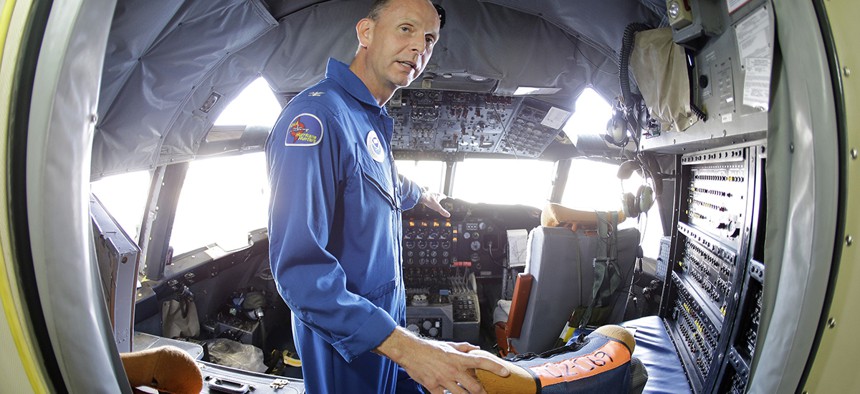When Hurricane Hunters Are Replaced by Drones

U.S. Navy Capt. Harris Halverson, shown in this ultra wide angle photo, demonstrates some of the functions in the cockpit of the National Oceanic and Atmospheric Administration's P-3 turboprop aircraft "Miss Piggy". Chris O'Meara/AP
For more than 70 years, pilots have flown into the center of deadly storms to collect crucial scientific and forecasting data. Is it time to have robots do that work for them?
Flying an airplane into a hurricane is, from practically all accounts, a surreal experience. Humans have been doing it since at least 1944, when the United States Air Force established its 53rd Weather Reconnaissance Squadron—a group better known as the Hurricane Hunters.
In September 1954, the journalist Edward R. Murrow joined them as they flew into the eye of Hurricane Edna—a deadly, Category 3 storm that walloped the East Coast of the United States.
“The eye of a hurricane is an excellent place to reflect upon the puniness of man and his work,” Murrow said in a subsequent broadcast about the experience.
Today, the Hurricane Hunters operate as part of a fleet within the National Oceanic and Atmospheric Administration, and they still gather critical data for hurricane forecasting and modeling—plus other geographic and environmental information that’s essential for understanding climate change.
NOAA has two four-engine WP-3D planes—known respectively as “Kermit” and “Miss Piggy”—it sends on grueling 10-hour storm-tracking missions. (Along with several other medium-range weather-reconnaissance aircrafts in the fleet, the agency also uses a twin-engine Gulfstream IV nicknamed “Gonzo.”)
In addition to the weather data that comes from satellites, the information collected firsthand by the Hurricane Hunters is crucial for public safety and scientific understanding. But in an age of drones, why are people still flying into hurricanes at all?
“Like anything thing else in the world, we’re staring down a proverbial barrel of man versus machine,” said Jeffrey Long, a former U.S. Air Force Hurricane Hunter Dropsonde Systems Operator. (A dropsonde is a tube-like device dropped from an aircraft into a storm to collect data about it.)
In 2014, scientists successfully sent an unmanned aircraft—a kind of surveillance probe known as the Coyote—into a hurricane churning above the Atlantic Ocean. These drones, deployed from a regular NOAA P-3 aircraft and directed by the pilots on board, are able to glide to just above the ocean surface, where they can determine a hurricane’s structure and intensity.
“Its relative lightweight design requires the Coyote to fly with the wind currents, but it will be directed up, down, and sideways to measure the storm’s inner core and storm activity at the lowest altitudes,” NOAA wrote in an announcement at the time.
The Coyote is still in a research and development phase, similar to the agency’s work on a new drone project focused on sensing high impact weather-related hazards like tropical storms, winter storms, and major floods.
“There are no plans as of now to replace anything in our fleet [with drones], just supplement additional work,” said Kevin Doremus, a spokesman in NOAA’s Office of Marine and Aviation Operations. “The [unmanned aircraft systems] are a great addition to the fleet, as it allows us to get an airborne asset in areas where it is too dangerous, to difficult, or too expensive to get a manned aircraft.”
But unmanned airplanes are already poised to transform the skies. Missy Cummings, the head of Duke’s Robotics lab and a former Navy fighter pilot, told me in May she believes drones will replace manned aircrafts much faster than many people realize.
“In 50 years, there will be no piloted cargo aircraft,” she said. “It will [begin to] happen much sooner, but by 50 years, there just won’t be a human anymore.”
It seems likely, then, the Hurricane Hunters will eventually be an unmanned squad, too. Long, who took 66 flights through hurricanes over a 10-year-period—including the landfall flight of Hurricane Andrew in 1992—believes that transition will happen soon.
“The Hurricane Hunters have a fantastic, 70-year history and I enjoyed my years flying as a crew member,” he said. “But I can't see manned recon flights lasting much more than 10 more years. I just hope they're not decommissioned much sooner. I think the NOAA aircraft—Kermit, Miss Piggy and Gonzo—would be the last to go, but we might see a phased drawdown in the 10 Air Force WC-130 Hurricane Hunter aircraft with a drone replacement.”
There’s great scientific promise for unmanned aircraft, especially as technologies become cheaper and more sophisticated. But a change to drones will mean the loss of a rare perspective for humans into some of the most powerful storm systems on the planet.
On Murrow’s flight, he described a violent course through a solid sheet of water, moments before “brilliant sunlight hit us like a hammer” in the eye of the hurricane. It was, he said, like being inside “a great amphitheater, round as a dollar, with great clouds sloping up to 25,000 or 30,000 feet. The water down below looked like a blue Alpine lake with snow-clad mountains coming right down to the water's edge. It was a great bowl of sunshine.”
Murrow’s description, Long told me, is a stunning and impressive attempt to explain something that must be experienced firsthand to be understood.
“The experience of flying through a hurricane is nearly impossible to describe,” Long said. “I was a young man when I flew into hurricanes and I certainly couldn't describe the unbelievable beauty of any storm after I landed back then. Today, I don’t think I’m that much closer to being able to do so, either.”





